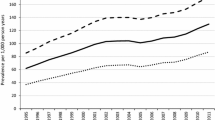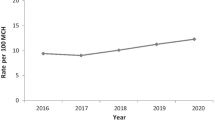Abstract
Objective
The use of antidepressants (ADs) has escalated and prompted considerable debate. Many depressed patients go unrecognised or under-treated and the area of indication of the new ADs is widening. The aim of this study was to analyse (i) the variation in general practitioners' prescribing of ADs by comparing with prescribing of other drug groups and (ii) whether the general prescribing behaviour, practice activity and demography are associated with the AD prescribing.
Methods
Analysis of AD prescribing patterns among 174 general practices (93.5%) in the County of Funen, Denmark. Age- and sex-standardised 1-year incidences and prevalences of AD prescribing for patients listed were calculated using individual prescription data from Odense University Pharmacoepidemiologic Database. Data about health services and practice demography were obtained from the Health Insurance Register. The variation in AD 1-year prevalence was compared with other drug groups by a variation index (90%/10% percentile). Univariate linear regression analysis was used to examine associations between practice characteristics and prescribing.
Results
The 1-year prevalence of AD prescribing varied sixfold, no more than the prevalence of five other drug groups. Practices with high yearly: general prescribing prevalence, mean number of drugs per medicated patient, number of surgery consultations/100 patients and counsellings/100 surgery consultations showed the highest yearly prevalence of AD prescribing. Single-handed practices had higher AD prescribing rates than partnerships. The relative use of selective serotonin re-uptake inhibitors and other new ADs showed only little variation (10% and 90% percentiles as close as 66–86%), but practices with high 1-year prevalence and incidence most often chose the new ADs.
Conclusion
Analysis of inter-practice variation showed no extraordinary quality problems with regard to AD prescribing, but does not exclude that there might be problems. The general prescribing pattern of the general practitioners seems essential to their attitude to AD prescribing. The relationship between counselling and prescribing was a feature specific to ADs and deserves further investigation. Quality indicators are needed to understand differences in AD prescribing, and studies based on prescription data have to be supplemented with individual clinical data.

Similar content being viewed by others
References
Rosholm JU, Andersen M, Gram LF (2001) Are there differences in the use of selective serotonin reuptake inhibitors and tricyclic antidepressants? A prescription database study. Eur J Clin Pharmacol 56:923–29
Isacsson G, Boëthius G, Henriksson S, Jones JK, Bergman U (1999) Selective serotonin reuptake inhibitors have broadened the utilisation of antidepressant treatment in accordance with recommendations. Findings from a Swedish prescription database. J Affect Disord 53:15–22
Laegemiddelkataloget (1998) Dansk Laegemiddel Information A/S. Copenhagen
Lecrubier Y (2001) Prescribing patterns for depression and anxiety worldwide. J Clin Psychiatry 62[Suppl 13]:31–36
Freeling P, Rao BM, Paykel ES, Sireling LI, Burton RH (1985) Unrecognised depression in general practice. Br Med J Clin Res Ed 290:1880–1883
Donoghue JM, Tylee A (1996) The treatment of depression: prescribing patterns of antidepressants in primary care in the UK. Br J Psychiatry 168:164–168
Lawrenson RA, Tyrer F, Newson RB, Farmer RDT (2000) The treatment of depression in UK general practice: selective serotonin reuptake inhibitors and tricyclic antidepressants compared. J Affect Disord 59:149–157
Barkham M, Hardy GE (2001) Counselling and interpersonal therapies for depression: towards securing an evidence-base. Br Med Bull 57:115–132
Girffrida A, Gravelle H, Roland M (1999) Measuring quality of care with routine data: avoiding confusion between performance indicators and health outcomes. BMJ 319:94–98
Anis AH, Carruthers SG, Carter OA, Kierulf J (1996) Variability in prescription drug utilization: issues for research. CMAJ 154:635–640
Gaist D, Sørensen HT, Hallas J (1997) The Danish prescription registries. Dan Med Bull 44:445–8
Pharaoah PDP, Melzer D (1995) Variation in prescribing of hypnotics, anxiolytics and antidepressants between 61 general practices. Br J Gen Pract 45:595–599
Ornstein S, Stuart G, Jenkins R (2000) Depression diagnoses and antidepressant use in primary care practices. A study from the practice partner research network (PRPNet). J Fam Pract 49:68–72
Steffensen FH, Schønheyder HC, Sørensen HT (1997) High prescribers of antibiotics among general practitioners—relation to prescribing habits of other drugs and use of microbiological diagnostics. Scand J Infect Dis 29:409–413
Schulberg HC, Block MR, Madonia MJ, Scott CP, Rodriguez E, Imber SD, Perel J, Lave J, Houck PR, Coulehan JL (1996) Treating major depression in primary care practice. Eight-month clinical outcome. Arch Gen Psychiatry 53:913–919
Butler R, Collins E, Katona C, Orrell M (2000) How do general pratitioners select antidepressants for depressed elderly people? Int J Geriatr Psychiatry 15:610–613
Isacsson G, Redfors I, Wasserman D, Bergman U (1994) Choice of antidepressants: questionnaire survey of psychiatrists and general practitioners in two areas of Sweden. BMJ 309:1546–1549
Acknowledgements
The authors wish to thank secretary Lise Stark for proofreading the manuscript. The study was funded by the Danish Research Foundation for General Practice, grant no. 585–148509, and complies with current legislation related to register research in Denmark.
Author information
Authors and Affiliations
Corresponding author
Rights and permissions
About this article
Cite this article
Gilså Hansen, D., Søndergaard, J., Vach, W. et al. Antidepressant drug use in general practice: inter-practice variation and association with practice characteristics. Eur J Clin Pharmacol 59, 143–149 (2003). https://doi.org/10.1007/s00228-003-0593-3
Received:
Accepted:
Published:
Issue Date:
DOI: https://doi.org/10.1007/s00228-003-0593-3




